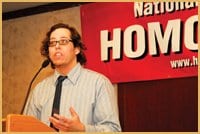Nearly two decades after homosexuality was de-listed from the World Health Organization’s registry of mental illnesses, many barriers to adequate and respectful medical treatment still exist for queers worldwide.
This year’s National Day Against Homophobia targeted the removal of homophobic, heterosexist, and transphobic behaviours and policies from all aspects of health care service in Canada.
On May 12, members of Vancouver’s queer community, health service providers and allies gathered at The Centre’s fourth annual National Day Against Homophobia breakfast to share ideas and raise awareness about the health care needs of queer Canadians. While the tone of the event was hopeful, speakers emphasized that work remains to be done in order to provide equal access for all.
Heterosexist or conventionally gendered presumptions made by care providers force queer patients to “bear the weight” of challenging them — or risk incomplete or improper treatment while seeking medical help, says registered nurse Julius Elefante.
According to a nationwide report by Statistics Canada released in March, gay men, lesbians and bisexuals were more likely to report unmet health care needs in the 2003 and 2005 Canadian and Community Health Surveys than were heterosexual men or women.
In particular, lesbians surveyed were significantly less likely to have had a recent pap test than either heterosexual or bisexual women. Men were not asked about preventive cancer screenings like the prostate-specific antigen test which, unlike pap smears and mammograms, is not covered by provincial medical plans in Alberta, Quebec, and BC.
Statistics Canada did not gather any data specific to the experiences of trans Canadians.
In spite of a good relationship with his general practitioner, trans activist Devon MacFarlane says he still encounters difficulty accessing some medical services.
“It’s not exactly easy to find appropriate referrals for trans people,” he says, recalling his “terror” at the thought of visiting a medical specialist unfamiliar with trans-specific needs after his doctor suggested he get a mammogram.
Peter Toppings, education and outreach program coordinator for The Centre, says health service providers “need to weave ‘queer’ throughout the fabric of their organizations, into their policies [and] resource materials.”
Research has shown that those who feel comfortable disclosing their sexual identity make more use of the medical system.
Age, economics, ethnic and cultural factors also impact queer people’s access to medical services. Barriers to employment, like a lack of social support or secure housing, may also mean reduced health coverage and fewer choices when it comes to care.
“We fall through the cracks,” says Karen Joseph, a leader in Aboriginal and two-spirit activism in the city. She says First Nations queer and two-spirit people, especially those living on reservation land, often face marginalization both from their own nation and the broader queer community.
Inequality is “not just about how we are treated, it’s also about our families,” notes senior activist Christine Waymark.
Her experiences as an out lesbian who has had many encounters with the medical establishment are varied. In only the past month she has felt her partnership both “celebrated” and “silenced” by emergency medical technicians.
“My orientation is never a non-issue,” Waymark says. “We live in a world where heterosexuality is assumed. I need always for there to be attention given to my sexual orientation.”
Family was at the core of the US-based Human Rights Campaign’s recently completed Healthcare Equality Index (HEI), a survey of hospital policies and queer issues.
The Index asked 10 questions specific to each hospital’s policies around LGBT-specific training programs, the treatment and employment of queer people and their families, the existence of non-discrimination policies to protect queer and trans staff and patients, and the rights of same-sex parents of minor children.
Campaign president Joe Solmonese says the HEI delineates a “gold standard” of queer-friendly health care. The Human Rights Campaign hopes to launch a searchable database of participating hospitals on their website within the next few weeks.
Training is important for all health care practitioners, agrees MacFarlane, because a practitioner’s basic comfort level with queers does not automatically translate into competent handling of queer issues.
“We have experienced homophobia for most of our lifetime. It’s not enough to be quietly accepting,” says Waymark, adding she’d like to see sexual orientation explicitly acknowledged and even celebrated in hospitals and seniors homes.
Several queer-specific health initiatives are now underway in the Vancouver Coastal Health Region, including what Toppings calls an “explosion of queer/trans addiction services.” In 2006, The Centre released its own LGTB Health Matters training and resource book for local health and social service practitioners.
Toppings says the movement to remove health service inequity is “like a toddler, only beginning to take [its] first shaky steps. But,” he says, “rest assured we are walking.”

 Why you can trust Xtra
Why you can trust Xtra


